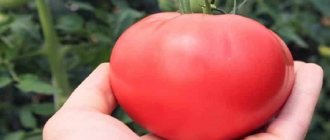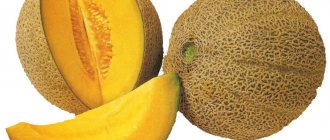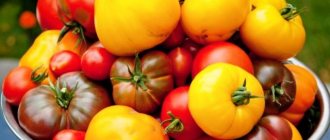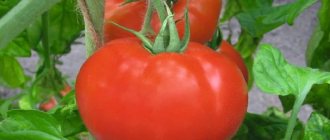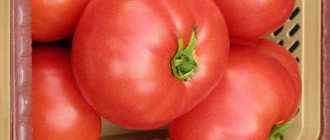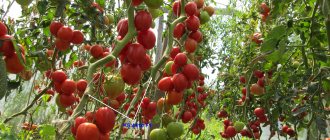Tomato Gulliver: variety description
| Variety name | Gulliver |
| general description | An early-ripening, determinant, high-yielding hybrid of Russian selection for cultivation in greenhouses and open ground. |
| Originator | Russia |
| Ripening period | 95-100 days |
| Form | Fruits are elongated with a rounded tip |
| Color | Red-pink |
| Average weight of tomatoes | 200 grams |
| Application | The variety is suitable for preparing salads, soups, sauces, juices, canning |
| Productivity of the variety | 7 kg per bush |
| Features of cultivation | Standard agricultural technology |
| Disease resistance | The hybrid resists major diseases well, but preventive measures will not hurt |
A variety of Russian selection, intended for growing in greenhouses made of polycarbonate or glass, in greenhouses and under film.
In regions with warm climates, planting in open ground is possible. The collected fruits are stored well and can withstand transportation without problems. Gulliver is a high-yielding early-ripening variety. The bushes are determinate, compact, up to 70 cm high. Read about indeterminate varieties here. Leaf mass is moderate.
It is recommended to form 2 or 3 stems using pinching; heavy branches with fruits require tying. Tomatoes ripen at the same time, fruiting lasts from July to September. The yield is very good; with proper care, up to 7 kg of tomatoes can be removed from the bush.
You can compare the yield of this variety with others in the table below:
| Variety name | Productivity |
| Gulliver | 7 kg per plant |
| Polbig | 4 kg per plant |
| Kostroma | 5 kg per bush |
| Lazy | 15 kg per square meter |
| Fat Jack | 5-6 kg per plant |
| Lady Shady | 7.5 kg per square meter |
| Bella Rosa | 5-7 kg per square meter |
| Dubrava | 2 kg per bush |
| Dad | 6 kg per bush |
| Pink spam | 20-25 kg per square meter |
Characteristics
Among the main advantages of the variety:
- tasty and beautiful fruits;
- good yield;
- tomatoes are suitable for salads and canning;
- disease resistance;
- undemanding to growing conditions.
The variety has practically no disadvantages. The only difficulty is tying up heavy branches that can break under the weight of the fruit.
Fruit characteristics:
- The fruits are large, fleshy, very beautiful.
- The average weight of a tomato is about 200 g, but larger specimens up to 800 g often ripen.
- During the ripening process, the color changes from light green to rich red-pink.
- The tomatoes are elongated, cylindrical, with a rounded tip.
- The pulp is tender, juicy, sugary, the seed chambers are small.
- The thick, glossy skin protects the fruit from cracking.
You can see the weight of fruits of other varieties in the table below:
| Variety name | Fruit weight |
| Gulliver | 200 grams |
| Red Guard | 230 grams |
| Diva | 120 grams |
| Yamal | 110-115 grams |
| The Golden Fleece | 85-100 grams |
| Red Arrow | 70-130 grams |
| Raspberry ringing | 150 grams |
| Verlioka | 80-100 grams |
| Countryman | 60-80 grams |
| Caspar | 80-120 grams |
The variety is suitable for preparing salads, soups, sauces, and juices. Smooth tomatoes with thick skin are good for canning; they are salted, pickled, and dried.
Advantages and disadvantages
- The advantages of this variety are:
- suitable for cultivation both in greenhouses and in unprotected soil;
- not demanding on care and climatic conditions;
- resistant to many tomato diseases;
- the ability to collect your own seeds;
- the fruits have a universal purpose.
- The disadvantages are:
- cultivation of this variety is recommended for the Central Black Earth Region (there is no data on how the variety will behave in other regions);
- average yield.
Features of cultivation
Seeds are sown for seedlings in early March; 60-70 days should pass before transplanting into the ground. Light soil made from a mixture of garden soil with peat or humus is preferable. Before planting, seeds are soaked in a growth stimulator and sown at a depth of 2 cm.
Most often they are sown in a container, but it is also possible to plant them in small peat pots. Individual packaging eliminates subsequent picking. For better germination, the containers are covered with film and placed in a warm place. You can use special mini-greenhouses.
After sprouting, tomatoes require bright light. In cloudy weather, seedlings are illuminated with electric lamps. The sprouts are watered with warm, settled water, preferably from a spray bottle or a fine-mesh watering can. After unfolding 2-3 sheets, picking is carried out. The seedlings are fed with liquid complex fertilizer, the second feeding is carried out before transplanting to a permanent place.
Plants should be planted in the greenhouse in the second half of May. Pour 1 tbsp into each well. spoon of complex mineral fertilizers. During the season, plants are fed 3-4 times, alternating potash and phosphorus fertilizers with organic matter. Read how to prepare soil in a greenhouse here. As for fertilizing, they use:
- Yeast.
- Iodine.
- Hydrogen peroxide.
- Ammonia.
- Ash.
- Boric acid.
Watering is carried out every 6-7 days; in between, the top layer of soil should dry out. As the fruits ripen, the branches are tied to a support. For successful formation of ovaries, it is recommended to form a bush with 2 or 3 stems.
How to care outdoors
The secret to a good tomato harvest is proper care after planting the seedlings for permanent residence. Therefore, we will describe in detail all the nuances.
Watering
Tomato bushes when planted unprotected must be watered regularly, most importantly - infrequently, but abundantly. If there is no rain, water once a week, and if it rains regularly, then less often.
Do not overwater the tomatoes, this will lead to diseases, but do not dry them, otherwise all the ovaries will fall off. Try to water the plant at the root so that moisture does not get on the leaves and fruits.
Experienced gardeners recommend using drip irrigation. In this case, the moisture goes directly to the root system and, if you water in the evening, you will avoid blossom end rot.
Feeding
For good development of the bush and a bountiful harvest, you need to use fertilizing. They need to be done at least 3 times per season, but it is better to fertilize every 2 weeks.
Find out what to spray tomatoes for ovary.
Choose fertilizers at your discretion, but keep in mind that their nitrogen content is less than the phosphorus and potassium content.
We can recommend the following composition for 10 liters of water:
- ammonium nitrate - 15 g;
- superphosphate - 50–60 g;
- potassium chloride - 30–40 g.
Tomatoes also respond well to a solution of bird droppings. To prepare it, take 1 liter of dry manure and 1 liter of water, mix and place in a warm place, let it ferment for several days. For watering, dilute the resulting mixture with water (1 part litter - 10 parts water).
Stepsoning
The “Gulliver” tomato variety does not need to be planted, but it is best to form a bush of 2-3 stems, which will not increase the load on the plant.
To do this, you need to wait for the first brush, and then leave one side shoot near it (if you need 2 stems) or an even stronger shoot near the second stem (if you need 3 stems).
Soil care
The soil around tomato bushes must be maintained periodically. To do this, be sure to loosen the soil after watering or rain - this will remove the crust and allow air to freely reach the roots. Also, hill up the bush as necessary and remove all weeds.
To avoid the appearance of an earthen crust and constant loosening, severe drying out of the soil and the appearance of weeds, mulch the tomato beds. You can use straw, pine needles, compost, agrofibre.
Tying up a bush
A tomato such as “Gulliver” must be tied up due to its significant growth. This will not only protect the bush from diseases and pests, but will also make it easier for you to care for.
Find out how to properly tie tomatoes in open ground and in a greenhouse.
Let's consider several ways of gartering:
- Using a peg . This is the simplest and most common method, in which pre-prepared stakes are deepened near each bush at a distance of 10 cm. Then a string of the required length is attached to the peg, and the tomato is loosely tied as it grows. For “Gulliver”, prepare stakes at least 1.8 m long from wood or metal.
- Trellis . This method is recommended in case of a large number of bushes. To make a trellis, you need 2 strong posts (wooden or metal) 2 m long, which must be driven into the ends of the tomato ridge. A wire is tightly pulled between them - maybe once higher, or several times, but at different heights. The garter is made loosely using twine.
- Bush cage . This method is the most time-consuming, but it will last more than one season. To make a cage, you need to prepare several circles from thick wire with a diameter larger than the width of the bush, then fasten them with vertical posts in the shape of a cylinder. Such cells need to be made according to the number of bushes and installed near each one. It should be tied with twine as the plant grows.
Pests and diseases
The variety is insensitive to fungal and viral diseases. However, when plantings are thickened, infections are possible. Frequent ventilation, removing the lower leaves on the bush and mulching the soil will help prevent them.
It is useful to spray young plants with phytosporin, a pale pink solution of potassium permanganate and copper-containing preparations. Dried or damaged leaves and fruits are immediately destroyed.
In greenhouses, plants can be affected by aphids, thrips or spider mites. Ventilation and timely destruction of weeds will help prevent the appearance of pests.
Plants affected by aphids are washed with a warm soapy solution; insecticides will help destroy the mite. Treatment is carried out 2-3 times with an interval of several days. After the start of fruiting, the use of toxic drugs is prohibited.
Read more on our website: What diseases most often threaten tomatoes in greenhouses and how to fight them? Which varieties are resistant to late blight, what kind of disease is it and how to protect yourself from it? What are the dangers of Alternaria, Fusarium, Verticillium and which varieties are not susceptible to these scourges?
Gulliver is a good choice for owners of greenhouses and greenhouses. Tomatoes need timely feeding and staking; with proper care, the plants will reward you with an excellent harvest.
Useful video
The following video explains how to properly form a tomato bush in a greenhouse. It will be useful for gardeners who decide to grow Gulliver tomatoes.
In the table below you will find links to other tomato varieties with different ripening periods:
| Mid-season | Mid-late | Mid-early |
| Marshmallows in chocolate | French grape | Pink Bush F1 |
| Gina TST | Golden Raspberry Miracle | Flamingo |
| Striped chocolate | Miracle of the market | Openwork |
| Ox heart | gold fish | Cio Cio San |
| Black Prince | De Barao Red | Supermodel |
| Auria | De Barao Red | Budenovka |
| Mushroom basket | De Barao Orange | Major F1 |
Advantages and disadvantages of the variety
Experienced vegetable growers have already managed to appreciate the advantages of the crop:
- Excellent taste.
- Plant resistance to low air temperatures and heat.
- Long shelf life of fresh fruits.
- Possibility of transportation over long distances.
- Universal use of vegetables.
No serious shortcomings were noted.
Information. Growing tomatoes in protected soil provides high yields, but in the garden the fruits are sweeter.
